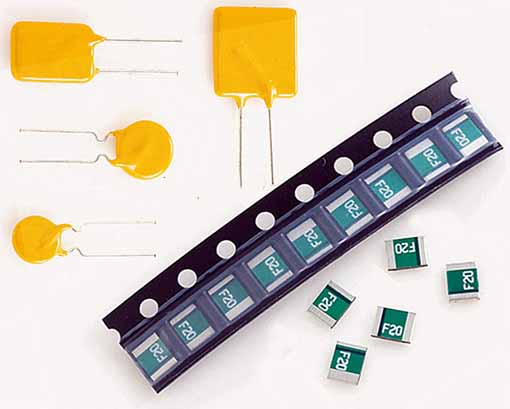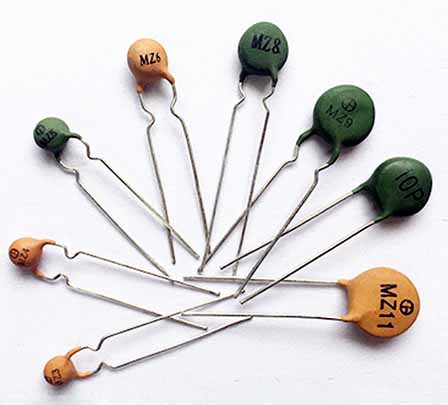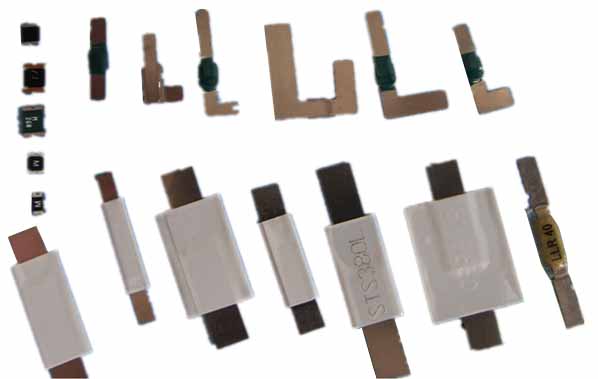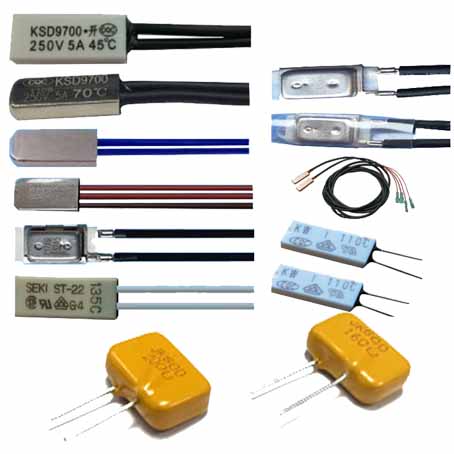Questions about polymer PTC thermistor fuse
Questions and answers about polymer resettable fuses

1. What are the main applications of polymer PTC thermistors?
Polymer PTC thermistors can be used in computers and their peripheral equipment, mobile phones, battery packs, remote communication and network equipment, transformers, industrial control equipment, automobiles and other electronic products to protect against overcurrent or overtemperature.2. What are the main differences between polymer PTC thermistors and fuses, bimetal circuit breakers, and ceramic PTC thermistors?
1) Difference with current fusePolymer PTC thermistor is a kind of conductive polymer material with positive temperature coefficient characteristics. The most significant difference between it and the fuse is that the former can be reused many times. Both of these products can provide overcurrent protection, but the same polymer PTC thermistor can be reused many times. After the fuse provides overcurrent protection, it must be replaced with another one.
2) Difference with bimetal circuit breaker
The main differences between polymer PTC thermistors and bimetal circuit breakers are:
The polymer PTC has been in the off state and will not reset until the accident is eliminated. However, the bimetal circuit breaker can reset itself when the accident still exists, which may cause electromagnetic waves and sparks during resetting. At the same time, reconnecting the circuit when the circuit is in a fault condition may damage the equipment, which is unsafe. The polymer PTC thermistor can maintain a high resistance state until the fault is eliminated.
3) Difference with ceramic PTC thermistor
The difference between the polymer PTC thermistor and the ceramic PTC thermistor lies in the initial resistance of the element, the protection action time (reaction time to accident events) and the difference in size. Compared with ceramic PTC thermistors, polymer PTC thermistors with the same holding current have smaller size, lower resistance, and faster response.
3. What is the working principle of polymer PTC thermistor?
Polymer PTC fuse is made of polymer material filled with carbon black particles. This material has a certain conductivity, so it can pass a rated current.If the current through the thermistor is too high, its heating power is greater than the heat dissipation power, at this time the temperature of the thermistor will start to rise. At the same time, the polymer matrix in the thermistor begins to expand, which separates the carbon black particles and causes the resistance to rise, thereby very effectively reducing the current in the circuit.
At this time, there is still a small current flowing in the circuit, and this current keeps the thermistor at a sufficient temperature to maintain a high resistance state. After troubleshooting, the polymer PTC thermistor will cool down quickly and will return to its original low resistance state, so that it can work again like a new polymer fuse.

4. How to judge the parameters of polymer PTC thermistor?
Most polymer PTC fuse housings are marked with product specifications or models. The standard product mark is also listed in the product specification. However, some signs can only be recognized by manufacturers or agents with recognition capabilities.5. Will the resistance value of a polymer PTC fuse change when it is not in a disconnected state?
The resistance value of the polymer PTC thermistor will change slightly as the working environment changes. Generally, the resistance value increases with the increase of temperature and current, and vice versa.6. How long is the storage period of polymer PTC thermistors?
If stored properly, there is no limit to the storage period of polymer PTC thermistors.If exposed to excessive moisture or high temperature, the performance of some specifications may change, such as the solderability of tin-lead. It can be stored for a long time under normal storage conditions of electrical components.
7. Under what circumstances can the polymer PTC fuse be reset? How fast is the reset?
Under normal circumstances, as long as the voltage loaded on both ends of the thermistor is removed, the thermistor can be reset; But if the external environment temperature is very high (such as 150 ℃) the thermistor cannot be reset.The time it takes for a polymer PTC fuse to return to a low resistance state depends on many factors:
Product type, assembly form, structure, external temperature, duration of open circuit, etc. Generally, the reset time is less than a few minutes, and in some cases it only takes a few seconds to reset the fuse.
8. Is the polymer PTC fuse reset automatically?
Once the fault is eliminated and the power supply is cut off, the fuse can be reset. At this time, the circuit needs to be disconnected (maintain current) to cool the thermistor.The polymer collective material in the thermistor shrinks due to cooling, so that the carbon black particles are reconnected, reducing the resistance. This is different from the automatic reset of the bimetallic device. The typical bimetal protection device can be reset even if the fault is not eliminated, which leads to constant switching between the fault state and the protection state, which may damage the equipment. However, the polymer PTC thermistor will remain in a high resistance state until the fault is eliminated.
9. Can the polymer PTC thermistor be cleaned?
Many common cleaning agents for electrical components can be used to clean the polymer PTC thermistor. However, some cleaning agents may damage the performance of the thermistor, it is best to test or consult our company before cleaning.

10. Can polymer PTC thermistors be used in parallel?
can. The main advantage of this is that the resistance can be reduced and the holding current can be increased.11. Can polymer PTC thermistors be used in series?
For most users, there is no benefit to this, and it is not practical to do so. Because there is always a polymer PTC thermistor disconnected first, other PTCs cannot provide additional protection at all.12. What effect does pressure have on polymer PTC thermistors?
The pressure applied to the thermistor may affect the electrical performance of the product. If the pressure is too great when the thermistor cuts off the circuit and restricts the expansion of the product, this will cause the thermistor to lose its specific function and be damaged. It should be noted that the thermistor cannot be installed in a place that restricts its expansion.13. What is the effect of encapsulating the polymer PTC thermistor?
Generally speaking, we do not advocate additional packaging for our company's thermistor products. If packaging must be carried out, attention should be paid to the choice of packaging materials. If the packaging material is too hard, it will hinder the expansion of the thermistor, thereby affecting the normal use of the thermistor. Even if a "soft" sealing material is used, the heat dissipation performance of the thermistor will be affected. The impact of packaging on product performance should be fully considered when selecting a model. If you need special packaging for the product, please consult our company.14. What is the failure mode of polymer PTC thermistor?
The typical failure mode of the polymer PTC thermistor is that the room temperature resistance of the product becomes too large. At this time, the holding current of the product will become smaller. In order to obtain UL certification, the thermistor must meet two standards:(1) It can break the circuit 6000 times and still have the self-recovery ability of PTC;
(2) Keep the open circuit state for 1000 hours and still have the self-recovery ability. If the thermistor exceeds its rated voltage or current in the fault state, or the number of breaks exceeds the UL testing requirements, the thermistor may deform and burn.

15. How many times can the polymer PTC fuse work under the maximum voltage or breaking current?
Each polymer PTC thermistor has a rated working voltage and can withstand a rated breaking current when a fault occurs. In order to obtain UL certification, the switch must be able to open 6000 times and maintain the self-recovery nature of PTC. For self-recovery fuses used in communication equipment (switches, training rack security units, etc.), the service life of the product is specified in the industry standard. This requires as few as tens of times to switch, and as many as hundreds of times to return to the initial characteristic value. The designer should keep in mind that the polymer PTC fuse is used to prevent malfunction, not to use its open circuit state as its normal state.16. What is the classification of the coating on the polymer PTC thermistor?
The packaging material for B series products is flame-retardant epoxy resin, and for D and DL series thermistors, polyester film is used. These materials meet the requirements of UL94V-0 or IEC95-2-2 standards.17. What is the maximum ambient temperature of the polymer PTC fuse during use?
It depends on the product series used. The ambient temperature of our products can reach 85°C in most use conditions, and for some product series (such as DL series products), it can only reach 70°C. For surface mount PTC products, it can withstand the soldering temperature in a short time. When the ambient temperature exceeds the switch protection temperature, the thermistor cannot work normally.18. What happens if the current exceeds the holding current IH, but does not reach the operating protection current IT?
The holding current IH refers to the maximum stable current that can pass through the polymer PTC fuse without causing its breaking action under specified external conditions. The operating current IT is the minimum stable current that will cause the open circuit of the polymer PTC fuse under specified conditions.At this time, the polymer resettable fuse can show different behaviors in different situations, which mainly include:Ambient temperature, assembly style, resistance value of thermistor, etc. Therefore, the thermistor may maintain a low resistance state, or act quickly, or it may take a long time to act.
The current value between IH and IT can be represented by an area, which is related to the on-off state of the thermistor, but the current value range cannot be accurately predicted. If the current is high enough, the thermistor may either maintain a low resistance state and maintain this low current or may change to a high resistance state, depending on the initial resistance of the thermistor, the external environment and the assembly conditions.





